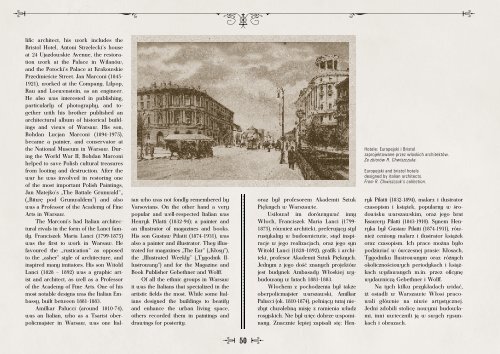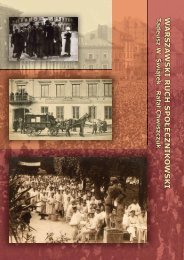Create successful ePaper yourself
Turn your PDF publications into a flip-book with our unique Google optimized e-Paper software.
lifi c architect, his work includes the<br />
Bristol Hotel, Antoni Strzelecki’s house<br />
at 24 Ujazdowskie Avenue, the restoration<br />
work at the Palace in Wilanów,<br />
and the Potocki’s Palace at Krakowskie<br />
Przedmieście Street. Jan Marconi (1845-<br />
1921), worked at the Company, Lilpop,<br />
Rau and Loewenstein, as an engineer.<br />
He also was interested in publishing,<br />
particularly of photography, and together<br />
with his brother published an<br />
architectural album of historical buildings<br />
and views of Warsaw. His son,<br />
Bohdan Lucjan Marconi (1894-1975),<br />
became a painter, and conservator at<br />
the National Museum in Warsaw. During<br />
the World War II, Bohdan Marconi<br />
helped to save Polish cultural treasures<br />
from looting and destruction. After the<br />
war he was involved in restoring one<br />
of the most important Polish Paintings,<br />
Jan Matejko’s „The Battale Grunwald”„<br />
(„Bitwę pod Grunwaldem”) and also<br />
was a Professor of the Academy of Fine<br />
Arts in Warsaw.<br />
The Marconi’s had Italian architectural<br />
rivals in the form of the Lanci family.<br />
Franciszek Maria Lanci (1799-1875)<br />
was the fi rst to work in Warsaw. He<br />
favoured the „rustication” as opposed<br />
to the „asher” style of architecture, and<br />
inspired many imitators. His son Witold<br />
Lanci (1828 – 1892) was a graphic artist<br />
and architect, as well as a Professor<br />
of the Academy of Fine Arts. One of his<br />
most notable designs was the Italian Embassy,<br />
built between 1881-1883.<br />
Amilkar Palucci (around 1810-74),<br />
was an Italian, who as a Tsarist oberpolicmajster<br />
in Warsaw, was one Ital-<br />
ian who was not fondly remembered by<br />
Varsovians. On the other hand a very<br />
popular and well-respected Italian was<br />
Henryk Pilatti (1832-94); a painter and<br />
an illustrator of magazines and books.<br />
His son Gustaw Pilatti (1874-1931), was<br />
also a painter and illustrator. They illustrated<br />
for magazines „The Ear” („Kłosy”),<br />
the „Illustrated Weekly” („Tygodnik Illustrowany”)<br />
and for the Magazine and<br />
Book Publisher Gebethner and Wolff .<br />
Of all the ethnic groups in Warsaw<br />
it was the Italians that specialized in the<br />
artistic fi elds the most. While some Italians<br />
designed the buildings to beatify<br />
and enhance the urban living space,<br />
others recorded them in paintings and<br />
drawings for posterity.<br />
50<br />
oraz był profesorem Akademii Sztuk<br />
Pięknych w Warszawie.<br />
Usiłował im dorównywać inny<br />
Włoch, Franciszek Maria Lanci (1799-<br />
1875), również architekt, preferujący styl<br />
rustykalny w budownictwie, stąd inspiracje<br />
w jego realizacjach, oraz jego syn<br />
Witold Lanci (1828–1892), grafi k i architekt,<br />
profesor Akademii Sztuk Pięknych.<br />
Jednym z jego dość znanych projektów<br />
jest budynek Ambasady Włoskiej wybudowany<br />
w latach 1881-1883.<br />
Włochem z pochodzenia był także<br />
oberpolicmajster warszawski, Amilkar<br />
Palucci (ok. 1810-1874), pełniący tutaj niezbyt<br />
chwalebną misję z ramienia władz<br />
rosyjskich. Nie był więc dobrze wspominany.<br />
Znacznie lepiej zapisali się: Hen-<br />
Hotele: Europejski i Bristol<br />
zaprojektowane przez włoskich architektów.<br />
Ze zbiorów R. Chwiszczuka.<br />
Europejski and bristol hotels<br />
designed by italian architects.<br />
From R. Chwiszczuk’s collection.<br />
ryk Pilatti (1832-1894), malarz i ilustrator<br />
czasopism i książek, popularny w środowisku<br />
warszawskim, oraz jego brat<br />
Ksawery Pilatti (1843-1910). Synem Henryka<br />
był Gustaw Pilatti (1874-1931), również<br />
ceniony malarz i ilustrator książek<br />
oraz czasopism. Ich prace można było<br />
podziwiać w ówczesnej prasie: Kłosach,<br />
Tygodniku Ilustrowanym oraz różnych<br />
okolicznościowych periodykach i książkach<br />
wydawanych m.in. przez ofi cynę<br />
wydawniczą Gebethner i Wolff .<br />
Na tych kilku przykładach widać,<br />
iż osiadli w Warszawie Włosi pracowali<br />
głównie na niwie artystycznej.<br />
Jedni zdobili stolicę nowymi budowlami,<br />
inni uwiecznili ją w swych rysunkach<br />
i obrazach.




